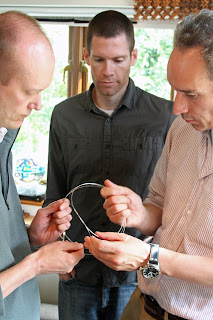Mathematics has the reputation of being an esoteric science wrapped up in theoretical objects that have no place in the physical world. But what is mathematics if not a huge elaborate game? You lay down your rules (axioms) at the start, set up your pieces (algebraic structure) and follow the game until you reach the end (solve your problem).
With this in mind Alain Goriely, Jon Chapman, Derek Moulton, Thomas Lessinnes and myself journeyed all the way to Devon to meet the wonderful James Dalgety, curator of the world’s biggest collection of puzzles and related ephemera. Our goal was to discover pieces amongst James’ 50,000+ puzzles that highlighted and demonstrated key mathematical ideas in a physical manner and, thus, could be used to form the basis of a puzzle exhibition in honour of the opening of the new University of Oxford Mathematical Institute.
 |
| Figure 1. James (centre) presenting just a small fraction of his entire collection to admiring crowd of (left to right) Derek, Alain, Jon and Thomas. |
James’ tour through his house-cum-gallery took over four hours and spanned three large rooms, which were filled to bursting point with every conceivable puzzle type. Simply put, we were kids in a candy shop! Although we saw a great number of puzzles and even had a chance to try out our problem solving abilities, we hardly scratched the surface of his entire collection as beneath every full cabinet was a set of drawers, each carefully sorted and catalogued to contain a specific type of puzzle. Even within each category of puzzle James would have a number of examples, ranging from updated versions fresh from a 3D printer to originals, which entertained troops in first world war trenches. Indeed, the collection is of much an historical and anthropological interest as it would be to any puzzle enthusiast.
Throughout the day James provided a constant conveyor belt of entertaining puzzles for us to try. Although at this stage it is important to note that one of James’ house rules is: if you dismantle a puzzle then you cannot leave until it is solved. Personally, I am happy to say that we did Oxford proud and rose to the challenge. Working together (and with the odd nudge in the right direction from James) we were a match for any challenge. Alain and Thomas even managed to offer a solution to one of James’ previously unsolved French rebus plates.
By 7pm we felt we had encroached upon James’ hospitality enough, knowing full well that it would be another three hours before we got back to Oxford. We said our goodbyes, signed the guest book and set off with grins on our faces and a long list of mathematical puzzles that would make perfect exhibits for the new institute.
Although it was the end of the day our work had just begun. We now have to refine our ideas and consider the specifics of the exhibition. Not only do we want James’ puzzles to be the centerpiece but we also need to create accompanying texts and explanations to show how the maths and the puzzles fit together. But that is a story for another day.


